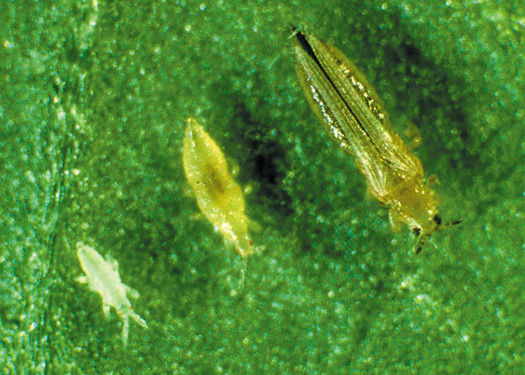Thrips

Definition
Thrips are characterized by their small size and their flat and elongated body, these insects belong to the order Thysanoptera. The adult thrips has four feathery wings. Their hue varies from gray to yellow or brown. Thrips are carriers of viruses such as Tospovirus. These viruses cause considerable crop losses.
Thrips are tiny elongated insects measuring 1 to 2 mm, which makes them difficult to observe with the naked eye.
The females, slightly larger than the males, have a variable colored abdomen but darker and rounder with a point at the end. The larvae are more elongated, wingless and very slow.
Proliferation of thrips

The first stage of the thrips life cycle is the egg, which hatches much faster if the temperature is high. Thrips are therefore fond of growing areas where the temperature is very high, such as greenhouses, growing rooms...
The females lay their eggs in the tissues of the plant. The larva that emerges from the egg feeds on the surrounding tissue. One of the characteristics of these insects is that they make the transition from pupa to adult in the soil or on the lower leaves. The larvae live on the leaves, but as soon as they reach the appropriate developmental stage, they fall to the ground or onto the lower leaves where they live during the pre-pupal and pupal stages until they transform into winged adults capable of reproduction. The entire life cycle lasts only a few weeks.
Adult thrips feed mainly on pollen, and larvae on tissue, liquid plant cells. Their diet consists mainly of leaves, petals, shoots and fruits.
Symptoms

Like whitefly attacks there are direct and indirect symptoms.
The first direct symptoms are manifested by the very clear discoloration, even almost transparent, of the leaf with black dots (which correspond to the faecal secretions).
Their mandible rasps the plant tissues to shred and suck them up. Holes or transparent areas are formed under the upper layer of the tissue in the center of the spot.
indirect symptoms are the saliva of thrips, which is toxic for flowers and shoots.
In cases of severe infestations, the leaves may dry up completely. Also, some thrips, like Frankliniella occidentalis, secrete a few drops of a substance when threatened by a predator. These excretions contain decyl acetate and dodecyl acetate, pheromones that send a warning signal to other thrips nearby.
Since thrips are capable of transmitting viruses, it is important to keep a close eye on your plants and detect thrips as soon as possible.
How to control thrips?
Be sure to clean the grow room thoroughly, take out all plants, and pick up and discard substrate residue on the floor and tables.
The usual scouting method is to use sticky traps. These traps are preferably blue, a color that strongly attracts thrips. The traps should be inspected regularly with a magnifying glass to see if any thrips (normally winged adults) have been caught in the trap.
You can also spray the plants with a natural insecticide such as potassium soap or plant extracts with pyrethrum. Plants should be sprayed thoroughly throughout, as thrips take refuge under the leaf grooves.
Biological control
Entomophagous fungi can also be used to control thrips.
Beauveria bassiana is one of the fungi commonly used to control thrips.
